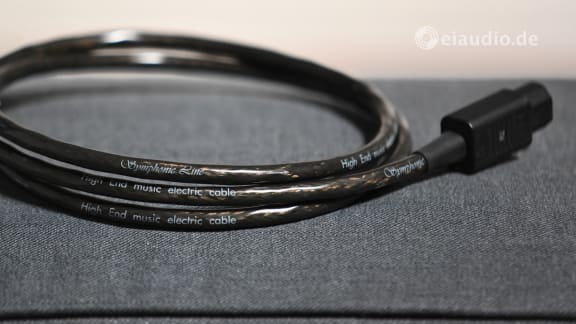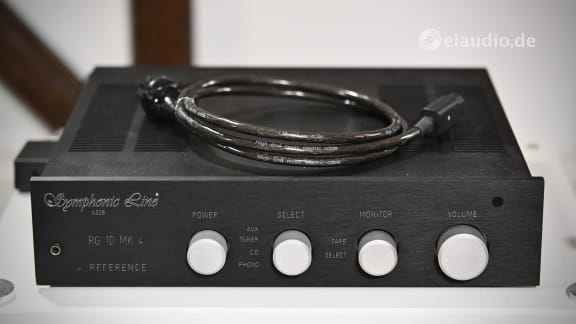Symphonic Line High End music electric cable
Published: 29/03/2025
Manufacturing date: 2025
Author: Karsten Hein
Category: Gear & Review
Tag(s): Power Cables
If you are a cables-don’t-matter-person and believe that even lamp cord is perfectly suitable for amplifier-to-loudspeaker connections, then this article is not for you. To all those who know how to set up a good HiFi system and have the ears to approve it, the Symphonic Line High End music electric cable is a valuable asset in unleashing the performance of your High End amplifier.
A world of magic.
Join any public HiFi forum today, and you’ll quickly find fiery discussions about audio cables. These conversations often reach a stalemate between those convinced that quality cables significantly impact sound and those who argue that nearly any cable that completes a connection is sufficient. Interestingly, this pattern repeats itself, whether discussing interconnects, speaker cables, or power cords.
While many debates boil down to two questions—'Do cables really matter?' and 'Are High-End cables just snake oil?'—perhaps a more productive approach would be to step beyond personal opinions and anecdotes and to ask: Are forums, where contributors often use pseudonyms and vary greatly in experience, truly the ideal place to explore complex technical issues like cable quality?
Essentially, what cable-effect skeptics do not realise is that they ask us to believe in a magic trick by suggesting that they can change the medium without this having any effect on the crucial properties: capacitance, resistance, inductance, internal resonances, eddy currents, level of signal loss and interference, etc. To the skeptic, a cable will have the same effect on the frequency spectrum and the dynamics of music, regardless of whether it is of an unshielded silver solid-core design or, quite the opposite, a copper-clad aluminium multi-strand with mesh shielding. And this is simply not the case.
The magic of reality.
Back in the real world, the characteristics of cables are so divergent that I have hardly heard two signal cables on a HiFi system that had the same effect on music. Each cable has specific strengths and weaknesses that I accept and have learned to use to my advantage when setting up a system. Since on High End music systems, we normally do not have any attenuators for bass and treble, cable characteristics can be used to darken tonal colours, slow down or increase speed, or to make the HiFi system sound crisper, until the resulting balance sounds just right.
However, despite my personal experience with the importance of signal cables, it did take me some time to accept that this also applied to power cords. Music signals are obviously delicate and span a whole range of frequencies, whereas power cords are directly connected to the house electrical grid (often by means of a power distributor) and only have to handle one specific voltage and frequency (240 volts, 50 Hz for Europe). At first, this seemed like a simple enough job to me that just any cable could do, but, surprisingly, the audible differences between power cords are also quite substantial. Power, after all, is the basis for everything.
How is it possible that power cables contribute to sound?
For one thing, the home electrical installation is made up of solid-core copper wires. These are not certified for movable devices, because solid-core wires are rigid and can easily fracture when bent repeatedly and cause fires. It is for this reason that we change from solid-core to flexible multi-strand wires in a power cord. Doing so causes audible deviations within the electrical current flow. And since this degrading effect is located right before the music-processing device (CD-player, amplifier, etc.), where power integrity should ideally be getting better and not worse, the effect can be considerable.
The power cord is in a crucial position, because it becomes part of the resonance circuit of the respective music device. Its ability to provide clean, resonance free electricity in abundance is essential for the music signal to remain intact. Contrary to popular belief, the ability of a cord to support clean music reproduction does not show in the dimensions of its cable nor in the design of its shiny plugs. Power cords need to be evaluated in their effectiveness when applied in a real-world listening test. And this is precisely where the Symphonic Line High End music electric cable meets its mark.
Built for music.
The authentic reproduction of music signals across the frequency spectrum, with life-like dynamics, correct timing, and natural tonal colors, is a challenge and demands more attention to detail than the power supply of a heating, cooling, or light emitting device. Different rules apply to the design of a power supply and the cord that feeds it, and it takes lots of experience to get the balance just right.
Symphonic Line can look back on a 40-year history of engineering audio devices that satisfy the needs of audiophile High End listeners around the world. The company is owner-operated by its founder, Rolf Gemein, and offers a full range of true-to-source music devices, spanning from CD players, analog drives, integrated amplifiers, pre- and power amplifiers, to loudspeakers and the cables that make each device perform at its best. And as the resulting performance hardly ever hinges on a single device, improving the connections between them has been as important as the devices themselves.
The Symphonic Line High End music electric cable is based on a relatively new concept and was designed to unleash the full performance of High End amplifiers and related audio gear. It is an optical understatement and does not demand much visual attention. It feels light, soft to the touch, and is surprisingly flexible. The cord is moderately priced in the high-end segment, especially when we factor in the sound experience. Its conductors are made up of 2.5 mm2 and 1.5 mm2 multi-litz wires paired with an ultra-fast dielectric with the benefit of low dielectric absorption and fast polarity reversal. The cable uses a filler that is chaotic in structure for higher resonance absorption paired with a soft and transparent outer sheath for better decoupling from the floor.
The quality of workmanship is at the high level that has become the trademark of Symphonic Line products, and the resulting sound is breathtaking. “I wanted to design a cable that would indicate endless clean power reserves to the amplifier under all conditions”, Rolf Gemein said to me, as he was handing me the High End music electric cable for testing at the Norddeutsche HiFi-Tage. “Let me know what you think. And feel free to write about your experience.” On that day, I was taking the Manger P2 loudspeakers to write a review, and the prospect of having a great power cable to choose from presented a welcome opportunity for me.
Since then, I have tested the cable in combination with a Symphonic Line RG10 MK4 Reference amplifier, the Manger P2 bending wave transducers, and my own Martin Logan SL3 electrostatic speakers with a variety of music styles. And I have documented my highly positive experiences in my reviews on the RG10 MK4 Reference amplifier, the Manger P2 loudspeakers, and the WSS Platin Line LS4 speaker cables. All these articles have one thing in common: a power source that is fast and clear of harmful resonances.
Ways to perfection.
I did detect traces of HF interference, however, that the cable did not manage to filter completely, and I therefore decided to add one ferrite bead about 12 cm before the cable enters the amplifier. This immediately freed it from any trace of interference. The RG10 MK4 Reference is a sensitive and powerful amplifier that will take whatever we feed into it and amplify it to well above 50,000 Hz. As we have a large cellphone tower in our neighborhood with visual contact when looking out the window, I have not been able to use any power cable without a ferrite clamp. With cellphone coverage being present in an increasingly tight mesh, this same phenomenon might also apply to your location.
The finished setup allowed for clear and calm sound reproduction. Freed from resonances and HF interference, the RG10 MK4 Reference could realize its full dynamic potential. The music could sound powerful and massive yet delicate and sweet simultaneously, or shift dynamically within milliseconds.
This new potential changed my listening habits and made me favor Broadway musicals simply for the joy of dynamics and the multitude of instruments and voices. Rolf Gemein often talks about the importance of an even power distribution across the entire frequency range, rather than focusing on a single measuring point for better specifications. It is this characteristic that is special in the context of Symphonic Line amplifiers, especially when they are fed from a high quality power source.
With energy effortlessly moving to and from the amplifier, the recording distinguishes itself from the HiFi setup and becomes audible in all its dimensions. There is order on the tonal and dynamic scale at once. Performances take shape, and the body of music can be felt and not only heard in all its dimensions. Marco Kolks (link shows PDF of the German article) wrote about his experience with the High End music electric cable in the German publication “Hörerlebnis”, and I can only agree with his findings and congratulate him on his thoughtful and detailed analysis.
I feel that Rolf Gemein has succeeded at building a cable that provides amplifiers with unbridled clean power, which was his declared mission. If you have the chance to test it on your amplifier, this is certainly an experiment worth your time. Don't judge a book by its cover. The High End music electric cable will easily dwarf cables that look three times more impressive and are much higher priced. Here is one piece of the puzzle on the way to a true High End system.
Specifications
- Type: High End power cord
- Application: High End music sources and amplifiers
- Inner conductors: 2.5 mm² / 1.5 mm²
- Cable length: 160 cm (without plugs)
- Variations: Also available per meter.
- Cable diameter: 9 mm
- Weight: 350 g
- Country of manufacture: Germany
- Year(s): 2022 -




